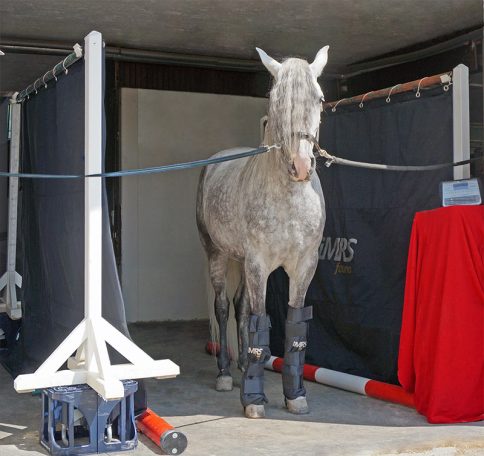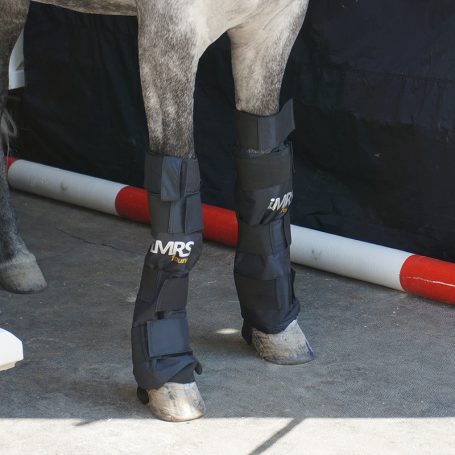EQUINE PEMF
Based on the existing human iMRS control unit special software was developed to operate the newly designed area- and leg applicators of the iMRS fauna. With the help of a specially programmed SD Card all application parameters can be uploaded and made available.
Owners of existing iMRS human systems are therefore able to use their control unit for the iMRS fauna applications as well. A simple firmware update will enable this function. To provide a practical, gentle and stress free application, the newly developed area applicators do not have to get in contact with the animal anymore. A simple suspension mechanism allows a variable, two-sided installation of both area applicators within the box. The animal will be positioned in the box and is automatically and non-intrusively exposed to the applied pulsed electro magnetic field.
The additional 2 leg applicators enable a more specific and local application for the lower extremities of the animal. The adjustable suspension mechanism and the choice of very durable yet light material ensure a fast, easy and highly effective use.
iMRS Fauna -
- Accompanying and supportive with a wide range of disease patterns
- Prevention of injury, reduced recovery times
- Improvement of regeneration and relaxation
- Activation of metabolic processes and overall vitality
- Deepening of breathing, increased cardiovascular vitality
- Support of healing processes increased mobility
- Performance enhancement
Intelligent Magnetic Resonance Stimulation (iMRS) has been professionally used in the veterinary field for decades as a supporting and accompanying modality with a wide range of health conditions. An additional growing application spectrum represents the usage for race and show horses as well as with livestock in the agricultural area.
Contact us for direct support or sales discussion! PEMF for the home, cabin, farm or track! 1-800-862-2960 get.pulsed@newlifepemf.ca
Pulsed electromagnetic field (PEMF) therapy is a treatment modality for horses in which pulses of electromagnetic fields are directed at specific parts of the body. Research suggests that PEMF can improve bone healing rates, regenerate and protect cartilage cells, and reduce pain and inflammation.
Equine veterinarians commonly use PEMF to treat musculoskeletal injuries such as bone fractures, arthritis, and soft tissue damage in horses. Some practitioners may use PEMF as part of an ongoing wellness routine to heal microfractures or microtears and reduce inflammation.
More research is necessary to determine the efficacy of PEMF in treating common lameness conditions in horses. Although equine research is lacking, the potential benefits and minimal side effects of PEMF make it a desirable treatment option for owners and veterinarians to support healing and recovery.
PEMF Therapy in Horses
The use of pulsed electromagnetic field (PEMF) therapy originated when researchers discovered stress applied to a bone during weight bearing induced an electrical current within the bone cells.
Researchers found these electrical currents enable bone tissues to sense mechanical forces, stimulating tissue remodeling (bone regeneration and structural changes) to better compensate for load bearing.
PEMF therapy leverages this concept by producing an electrical current within the tissue, with the hypothesis that the stimulation will trigger tissue remodeling without having to apply additional mechanical stress to the bone.
How PEMF Works
PEMF technology uses magnetic fields to create electrical currents within tissues. This makes it different from traditional electrical current therapies (e.g. shockwave therapy) in which an electrical current is produced directly by the machine. This allows PEMF treatment to affect deeper tissues that other therapies cannot access using standard treatment methods.
PEMF machines use coils of copper wire to produce an electromagnetic current. By running electricity through the wires, the travelling electrons produce a magnetic field.
The shape of the coil within the machine dictates the shape of the electromagnetic field. Many PEMF machines have coils designed to produce a strong local effect so the practitioner can direct treatment to a specific area.
Many PEMF machines also incorporate traditional electrical current treatment functionality as part of the device. This allows practitioners to combine the effects of electrical current treatment, such as shockwave, with the effects of PEMF therapy.
Effects on Tissue
Research on the impact of PEMF therapy on equine tissues is limited, but there are several studies from human medical literature. These studies report variable efficacy, with one review showing that only 51% of PEMF studies identified cellular changes.
According to studies showing positive effects of PEMF therapy, possible tissue changes include:
- Increased bone production (osteogenesis)
- Increased regeneration of cartilage cells
- Improved cartilage cell survival in joint tissues
- Anti-inflammatory effects in treated tissues
- Proliferation of stem cells
Bone Production
Many studies in PEMF-treated cells report cell proliferation or growth. In particular, PEMF therapy increases proliferation of osteoblasts, the main cells responsible for producing new bone tissue.
These findings are the basis for using PEMF therapy to treat bone fractures, as practitioners hypothesize increasing osteoblast proliferation promotes healing in the bone.
Regeneration and Protection of Cartilage
Research suggests cartilage tissues may also respond to electrical stimulation, similar to bone.
Research on the effects of PEMF on joint tissues shows that PEMF increases proliferation and survival of chondrocytes, the cells within joint cartilage.
When cartilage is compressed during weight bearing, the fluid component of the cartilage is pushed out, and electrolytes (electrically charged minerals) within the fluid may produce an electrical current. These electrical currents may produce a proliferation effect in cartilage, allowing it to compensate for increased load bearing.
Studies also show that PEMF can increase the production of proteoglycan, a major component of cartilage. Proteoglycan holds fluid within cartilage tissues, allowing the cartilage to act as a protective cushion during weight bearing. This cushioning effect pads the bones of the joint so they are not in direct contact, preventing pain associated with bone-on-bone rubbing and grinding when the joint is in use.
These findings suggest that PEMF may have applications in treating arthritis, a disease where the joint cartilage degenerates and causes pain.
Anti-inflammatory Changes
Studies in rats show that PEMF may have an anti-inflammatory effect. PEMF treatment can decrease the activity of neutrophils, a major inflammatory cell in the immune system. Decreasing the activity of these cells can have a protective effect on structural cells within the joint capsule.
Additionally, other studies show PEMF treatment can decrease levels of prostaglandin in a treated area. Prostaglandin is a major inflammatory protein that plays a role in the pain sensation associated with inflammation. By decreasing prostaglandin levels in an area, PEMF may reduce pain perception and improve comfort.
Stem Cell Proliferation
There is considerable research into the effect of PEMF on stem cells. Studies show PEMF can stimulate stem cells to transform into osteoblasts and chondrocytes. As stem cell therapy is an increasingly popular treatment for lameness in horses, these findings suggest that PEMF therapy may have a synergistic effect with stem cell treatment.
©Copyright. All rights reserved.
We need your consent to load the translations
We use a third-party service to translate the website content that may collect data about your activity. Please review the details in the privacy policy and accept the service to view the translations.








